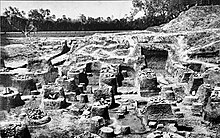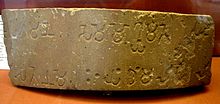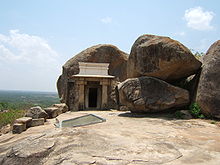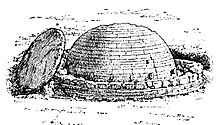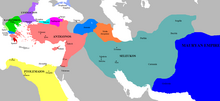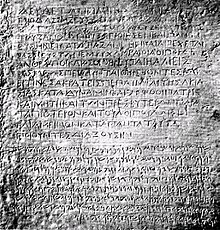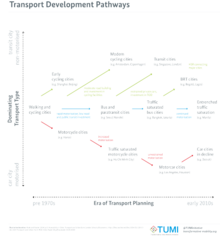Gupta Empire
| |||||||||||||||||||||||
|---|---|---|---|---|---|---|---|---|---|---|---|---|---|---|---|---|---|---|---|---|---|---|---|
| 3rd century CE–543 CE | |||||||||||||||||||||||
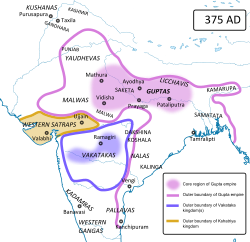
Approximate extent of the Gupta territories (purple) in 375 CE.
| |||||||||||||||||||||||
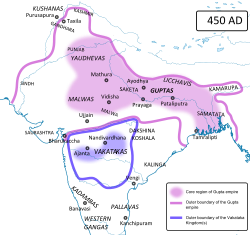
Approximate extent of the Gupta territories (purple) in 450 CE.
| |||||||||||||||||||||||
| Capital | Pataliputra | ||||||||||||||||||||||
| Common languages | Sanskrit (literary and academic); Prakrit (vernacular) | ||||||||||||||||||||||
| Religion | |||||||||||||||||||||||
| Government | Monarchy | ||||||||||||||||||||||
| Historical era | Ancient India | ||||||||||||||||||||||
• Established
| 3rd century CE | ||||||||||||||||||||||
• Disestablished
| 543 CE | ||||||||||||||||||||||
| Area | |||||||||||||||||||||||
| 400 est. | 3,500,000 km2 (1,400,000 sq mi) | ||||||||||||||||||||||
| 440 est. | 1,700,000 km2 (660,000 sq mi) | ||||||||||||||||||||||
| |||||||||||||||||||||||
The Gupta Empire was an ancient Indian
empire existing from the mid-to-late 3rd century CE to 543 CE. At its
zenith, from approximately 319 to 543 CE, it covered much of the Indian subcontinent. This period is considered as the Golden Age of India by some historians. The ruling dynasty of the empire was founded by the king Sri Gupta; the most notable rulers of the dynasty were Chandragupta I, Samudragupta, and Chandragupta II alias Vikramaditya. The 5th-century CE Sanskrit poet Kalidasa credits the Guptas with having conquered about twenty-one kingdoms, both in and outside India, including the kingdoms of Parasikas, the Hunas, the Kambojas, tribes located in the west and east Oxus valleys, the Kinnaras, Kiratas, and others.
The high points of this period are the great cultural
developments which took place primarily during the reigns of
Samudragupta, Chandragupta II and Kumaragupta I. Many of the literary
sources, such as Mahabharata and Ramayana, were canonised during this period. The Gupta period produced scholars such as Kalidasa, Aryabhata, Varahamihira, and Vatsyayana who made great advancements in many academic fields. Science and political administration reached new heights during the Gupta era .
The period gave rise to achievements in architecture, sculpture, and
painting that "set standards of form and taste [that] determined the
whole subsequent course of art, not only in India but far beyond her
borders".
Strong trade ties also made the region an important cultural centre and
established the region as a base that would influence nearby kingdoms
and regions in Burma, Sri Lanka, and Southeast Asia. The Puranas, earlier long poems on a variety of subjects, are also thought to have been committed to written texts around this period.
The empire eventually died out because of many factors such as
substantial loss of territory and imperial authority caused by their own
erstwhile feudatories, as well as the invasion by the Huna peoples (Kidarites and Alchon Huns) from Central Asia. After the collapse of the Gupta Empire in the 6th century, India was again ruled by numerous regional kingdoms.
Origin
| Gupta Empire 320 CE–550 CE | ||||||||||||||||||||||||||||||||||||
|---|---|---|---|---|---|---|---|---|---|---|---|---|---|---|---|---|---|---|---|---|---|---|---|---|---|---|---|---|---|---|---|---|---|---|---|---|
|
The homeland of the Guptas is uncertain. According to one theory, they originated in the present-day eastern Uttar Pradesh, where most of the inscriptions and coins of the early Gupta kings have been discovered. The proponents of this theory argue that according to the Puranas, the territory of the early Gupta kings included Prayaga, Saketa, and other areas in the Ganges basin. Another prominent theory locates the Gupta homeland in the present-day Bengal region, based on the account of the 7th century Chinese Buddhist monk Yijing. According to Yijing, king Che-li-ki-to (identified with the dynasty's founder Shri Gupta) built a temple for Chinese pilgrims near Mi-li-kia-si-kia-po-no (apparently a transcription of Mriga-shikha-vana). Yijing states that this temple was located more than 40 yojanas east of Nalanda, which would mean it was situated somewhere in the modern Bengal region. Another proposal is that the early Gupta kingdom extended from Prayaga in the west to northern Bengal in the east.
.
The Gupta records do not mention the dynasty's varna (social class). Some historians, such as A.S. Altekar, have theorized that they were of Vaishya origin, as some ancient Indian texts prescribe the name "Gupta" for the members of the Vaishya varna.
Critics of this theory point out that the suffix Gupta features in the
names of several non-Vaishyas before as well as during the Gupta period, and the dynastic name "Gupta" may have simply derived from the name of the family's first king Gupta. Some scholars, such as S.R. Goyal, theorize that the Guptas were Brahmanas, because they had matrimonial relations with Brahmanas, but others reject this evidence as inconclusive. Based on the Pune and Riddhapur inscriptions of the Gupta princess Prabhavati-gupta, some scholars believe that the name of her paternal gotra (clan) was "Dharana", but an alternative reading of these inscriptions suggests that Dharana was the gotra of her mother Kuberanaga.
History
Early rulers
Queen Kumaradevi and King Chandragupta I, depicted on a gold coin
Gupta
(fl. late 3rd century CE) is the earliest known king of the dynasty:
different historians variously date the beginning of his reign from
mid-to-late 3rd century CE. "Che-li-ki-to", the name of a king mentioned by the 7th century Chinese Buddhist monk Yijing, is believed to be a transcription of "Shri-Gupta" (IAST: Śrigupta), "Shri" being an honorific prefix.
According to Yijing, this king built a temple for Chinese Buddhist
pilgrims near "Mi-li-kia-si-kia-po-no" (believed to be a transcription
of Mṛgaśikhāvana).
In the Allahabad Pillar inscription, Gupta and his successor Ghatotkacha are described as Maharaja ("great king"), while the next king Chandragupta I is called a Maharajadhiraja ("king of great kings"). In the later period, the title Maharaja was used by feudatory rulers, which has led to suggestions that Gupta and Ghatotkacha were vassals (possibly of Kushan Empire). However, there are several instances of paramount sovereigns using the title Maharaja,
in both pre-Gupta and post-Gupta periods, so this cannot be said with
certainty. That said, there is no doubt that Gupta and Ghatotkacha held a
lower status and were less powerful than Chandragupta I.
Chandragupta I married the Lichchhavi
princess Kumaradevi, which may have helped him extend his political
power and dominions, enabling him to adopt the imperial title Maharajadhiraja. According to the dynasty's official records, he was succeeded by his son Samudragupta. However, the discovery of the coins issued by a Gupta ruler named Kacha
have led to some debate on this topic: according to one theory, Kacha
was another name for Samudragupta; another possibility is that Kacha was
a rival claimant to the throne.
Samudragupta
Coin of Samudragupta, with Garuda pillar. British Museum.
Samudragupta succeeded his father around 335 or 350 CE, and ruled until c. 375 CE. The Allahabad Pillar inscription, composed by his courtier Harishena, credits him with extensive conquests. The inscription asserts that Samudragupta uprooted 8 kings of Aryavarta, the northern region, including the Nagas. It further claims that he subjugated all the kings of the forest region, which was most probably located in central India. It also credits him with defeating 12 rulers of Dakshinapatha, the southern region: the exact identification of several of these kings is debated among modern scholars, but it is clear that these kings ruled areas located on the eastern coast of India. The inscription suggests that Samudragupta advanced as far as the Pallava kingdom in the south, and defeated Vishnugopa, the Pallava regent of Kanchi.
During this southern campaign, Samudragupta most probably passed
through the forest tract of central India, reached the eastern coast in
present-day Odisha, and then marched south along the coast of Bay of Bengal.
The Allahabad Pillar inscription mentions that rulers of several frontier kingdoms and tribal oligarchies paid Samudragupta tributes, obeyed his orders, and performed obeisance before him. The frontier kingdoms included Samatata, Davaka, Kamarupa, Nepala, and Karttripura. The tribal oligarchies included Malavas, Arjunayanas, Yaudheyas, Madrakas, and Abhiras, among others.
Finally, the inscription mentions that several foreign kings
tried to please Samudragupta by personal attendance; offered him their
daughters in marriage (or according to another interpretation, gifted
him maidens); and sought the use of the Garuda-depicting Gupta seal for administering their own territories. This is an exaggeration: for example, the inscription lists the king of Simhala among these kings. It is known that from Chinese sources that the Simhala king Meghavarna sent rich presents to the Gupta king requesting his permission to build a Buddhist monastery at Bodh Gaya: Samudragupta's pangyerist appears to have described this act of diplomacy as an act of subservience.
Samudragupta appears to have been Vaishnavite, as attested by his Eran inscription, and performed several Brahmanical ceremonies. The Gupta records credit him with making generous donations of cows and gold. He performed the Ashvamedha
ritual (horse sacrifice), which was used by the ancient Indian kings to
prove their imperial sovereignty, and issued gold coins to mark this performance.
The Allahabad Pillar inscription presents Samudragupta as a wise
king and strict administrator, who was also compassionate enough to help
the poor and the helpless. It also alludes to the king's talents as a musician and a poet, and calls him the "king of poets". Such claims are corroborated by Samudragupta's gold coins, which depict him playing a veena.
Samudragupta appears to have directly controlled a large part of the Indo-Gangetic Plain in present-day India, as well as a substantial part of central India.
Besides, his empire comprised a number of monarchical and tribal
tributary states of northern India, and of the south-eastern coastal
region of India.
Maximum extent of Gupta Empire during chandragupta II, 414 AD including tributaries
Ramagupta
Head of Tirthankara, Mathura Museum
Although, the narrative of the Devichandragupta is not
supported by any contemporary epigraphical evidence, the historicity of
Rama Gupta is proved by his Durjanpur inscriptions on three Jaina
images, where he is mentioned as the Maharajadhiraja. A large number of his copper coins also have been found from the Eran-Vidisha region and classified in five distinct types, which include the Garuda, Garudadhvaja, lion and border legend types. The Brahmi legends on these coins are written in the early Gupta style.
In the opinion of art historian Dr. R.A. Agarawala, D. Litt., Rama
Gupta may be the eldest son of Samudragupta. He became king because of
being the eldest. It is possible that he was dethroned because of being
considered unfit to rule, and his younger brother Chandragupta II took
over.
Chandragupta II "Vikramaditya"
Krishna fighting the horse demon Keshi, 5th century
According to the Gupta records, amongst his sons, Samudragupta
nominated prince Chandragupta II, born of queen Dattadevi, as his
successor. Chandragupta II, Vikramaditya (the Sun of Power), ruled from 375 until 415. He married a Kadamba princess of Kuntala and of Naga lineage (Nāgakulotpannnā), Kuberanaga. His daughter Prabhavatigupta from this Naga queen was married to Rudrasena II, the Vakataka ruler of Deccan.
His son Kumaragupta I was married to a Kadamba princess of the
Karnataka region. Chandragupta II expanded his realm westwards,
defeating the Saka Western Kshatrapas of Malwa, Gujarat and Saurashtra in a campaign lasting until 409. His main opponent Rudrasimha III
was defeated by 395, and he crushed the Bengal chiefdoms. This extended
his control from coast to coast, established a second capital at Ujjain and was the high point of the empire.
Gold coins of Chandragupta II.
Despite the creation of the empire through war, the reign is remembered for its very influential style of Hindu
art, literature, culture and science, especially during the reign of
Chandragupta II. Some excellent works of Hindu art such as the panels at
the Dashavatara Temple in Deogarh
serve to illustrate the magnificence of Gupta art. Above all, it was
the synthesis of elements that gave Gupta art its distinctive flavour.
During this period, the Guptas were supportive of thriving Buddhist and Jain cultures as well, and for this reason, there is also a long history of non-Hindu Gupta period art. In particular, Gupta period Buddhist art was to be influential in most of East and Southeast Asia. Many advances were recorded by the Chinese scholar and traveller Faxian (Fa-hien) in his diary and published afterwards.
The court of Chandragupta was made even more illustrious by the fact that it was graced by the Navaratna (Nine Jewels), a group of nine who excelled in the literary arts. Amongst these men was Kālidāsa,
whose works dwarfed the works of many other literary geniuses, not only
in his own age but in the years to come. Kalidasa was mainly known for
his subtle exploitation of the shringara (romantic) element in his verse.
Chandragupta II's Campaigns against Foreign Tribes
The 4th century Sanskrit poet Kalidasa
credits Chandragupta Vikramaditya with conquering about twenty-one
kingdoms, both in and outside India. After finishing his campaign in
East and West India, Vikramaditya (Chandragupta II) proceeded
northwards, subjugated the Parasikas, then the Hunas and the Kambojas tribes located in the west and east Oxus valleys respectively. Thereafter, the king proceeded into the Himalaya mountains to reduce the mountain tribes of the Kinnaras, Kiratas, as well as India proper.
The Brihatkathamanjari of the Kashmiri writer Kshemendra states, King Vikramaditya (Chandragupta II) had "unburdened the sacred earth of the Barbarians like the Sakas, Mlecchas, Kambojas, Yavanas, Tusharas, Parasikas, Hunas, and others, by annihilating these sinful Mlecchas completely".
Faxian
Faxian (or Fa Hsien etc.), a Chinese Buddhist, was one of the pilgrims who visited India during the reign of the Gupta emperor Chandragupta II.
He started his journey from China in 399 and reached India in 405.
During his stay in India up to 411, he went on a pilgrimage to Mathura, Kannauj, Kapilavastu, Kushinagar, Vaishali, Pataliputra, Kashi, and Rajagriha,
and made careful observations about the empire's conditions. Faxian was
pleased with the mildness of administration. The Penal Code was mild
and offenses were punished by fines only. From his accounts, the Gupta
Empire was a prosperous period. And until the Rome–China trade axis was
broken with the fall of the Han dynasty, the Guptas did indeed prosper.
His writings form one of the most important sources for the history of
this period.
Kumaragupta I
Silver coin of the Gupta King Kumaragupta I (Coin of his Western territories, design derived from the Western Satraps).
Obv: Bust of king with crescents, with traces of corrupt Greek script.
Rev: Garuda standing facing with spread wings. Brahmi legend: Parama-bhagavata rajadhiraja Sri Kumaragupta Mahendraditya.
Obv: Bust of king with crescents, with traces of corrupt Greek script.
Rev: Garuda standing facing with spread wings. Brahmi legend: Parama-bhagavata rajadhiraja Sri Kumaragupta Mahendraditya.
Chandragupta II was succeeded by his second son Kumaragupta I, born of Mahadevi Dhruvasvamini. Kumaragupta I assumed the title, Mahendraditya. He ruled until 455. Towards the end of his reign a tribe in the Narmada valley, the Pushyamitras, rose in power to threaten the empire. The Kidarites as well probably confronted the Gupta Empire towards the end of the rule of Kumaragupta I, as his son Skandagupta mentions in the Bhitari pillar inscription his efforts at reshaping a country in disarray, through reorganization and military victories over the Pushyamitras and the Hunas.
He was the founder of Nalanda University which on July 15, 2016 was declared as a UNESCO world heritage site.
Skandagupta
Skandagupta, son and successor of Kumaragupta I is generally considered to be the last of the great Gupta rulers. He assumed the titles of Vikramaditya and Kramaditya. He defeated the Pushyamitra threat, but then was faced with invading Kidarites (sometimes described as the Hephthalites or "White Huns", known in India as the Sweta Huna), from the northwest.
He repelled a Huna attack around 455 CE, but the expense
of the wars drained the empire's resources and contributed to its
decline. The Bhitari Pillar inscription of Skandagupta, the successor of Chandragupta, recalls the near-annihilation of the Gupta Empire following the attacks of the Kidarites. The Kidarites seem to have retained the western part of the Gupta Empire.
Skandagupta died in 467 and was succeeded by his agnate brother Purugupta.
Decline of the empire
The Alchon Huns under Toramana and his son Mihirakula (here depicted) contributed to the fall of the Gupta Empire.
Following Skandagupta's death, the empire was clearly in decline. He was followed by Purugupta (467–473), Kumaragupta II (473–476), Budhagupta (476–495), Narasimhagupta (495—530), Kumaragupta III (530—540), Vishnugupta (540—550), two lesser known kings namely, Vainyagupta and Bhanugupta.
In the 480's the Alchon Huns under Toramana and Mihirakula
broke through the Gupta defenses in the northwest, and much of the
empire in the northwest was overrun by the Huns by 500. The empire
disintegrated under the attacks of Toramana and his successor Mihirakula.
It appears from inscriptions that the Guptas, although their power was
much diminished, continued to resist the Huns. The Hun invader Toramana
was defeated by Bhanugupta in 510. The Huns were defeated and driven out of India in 528 by King Yashodharman from Malwa, and possibly Gupta emperor Narasimhagupta.
The much-weakened Late Guptas, circa 550 CE.
These invasions, although only spanning a few decades, had long term effects on India, and in a sense brought an end to Classical Indian civilization. Soon after the invasions, the Gupta Empire, already weakened by these invasions and the rise of local rulers such as Yashodharman, ended as well.
Following the invasions, northern India was left in disarray, with
numerous smaller Indian powers emerging after the crumbling of the
Guptas. The Huna invasions are said to have seriously damaged India's trade with Europe and Central Asia. In particular, Indo-Roman trade relations, which the Gupta Empire had greatly benefited from. The Guptas had been exporting numerous luxury products such as silk, leather goods, fur, iron products, ivory, pearl, and pepper from centres such as Nasik, Paithan, Pataliputra, and Benares. The Huna invasion probably disrupted these trade relations and the tax revenues that came with them.
Furthermore, Indian urban culture was left in decline, and Buddhism, gravely weakened by the destruction of monasteries and the killing of monks by the hand of the vehemently anti-Buddhist Shaivist Mihirakula, started to collapse. Great centres of learning were destroyed, such as the city of Taxila, bringing cultural regression. During their rule of 60 years, the Alchons are said to have altered the hierarchy of ruling families and the Indian caste system. For example, the Hunas are often said to have become the precursors of the Rajputs.
The succession of the 6th-century Guptas is not entirely clear,
but the tail end recognized ruler of the dynasty's main line was king Vishnugupta,
reigning from 540 to 550. In addition to the Hun invasion, the factors,
which contribute to the decline of the empire include competition from
the Vakatakas and the rise of Yashodharman in Malwa.
The last known inscription by a Gupta emperor is from the reign of Vishnugupta (the Damodarpur copper-plate inscription), in which he makes a land grant in the area of Kotivarsha (Bangarh in West Bengal) in 542/543 CE. This follows the occupation of most of northern and central India by the Aulikara ruler Yashodharman circa 532 CE.
Military organization
Sculpture of Vishnu (red sandstone), 5th century CE.
In contrast to the Mauryan Empire,
the Gupta's introduced several military innovations to Indian warfare.
Chief amongst these was the use of heavy cavalry archers and heavy sword
cavalry. The heavy cavalry formed the core of the Gupta army and were supported by the traditional Indian army elements of elephants and light infantry.
The utilization of horse archers in the Gupta period is evidenced on the coinage of Chandragupta II, Kumaragupta I and Prakasaditya (postulated to be Purugupta ) that depicts the emperors as horse-archers.
An 8 gm gold coin featuring Chandragupta II astride a caparisoned horse with a bow in his left hand
Unfortunately there is a paucity of contemporary sources detailing
the tactical operations of the Imperial Gupta Army. The best extant
information comes from the Sanskrit mahakavya (epic poem) Raghuvaṃśa written by the Classical Sanskrit writer and dramatist Kalidasa. Many modern scholars put forward the view that Kalidasa lived from the reign of Chandragupta II to the reign of Skandagupta and that the campaigns of Raghu -- his protagonist in the Raghuvaṃśa -- reflect those of Chandragupta II.
In Canto IV of the Raghuvamsa, Kalidasa relates how the king's forces
clash against the powerful, cavalry-centric, forces of the Persians and
later the Yavanas (probably Huns) in the North-West. Here he makes
special mention of the use horse-archers in the kings army and that the
horses needed much rest after the hotly contested battles.
Religion
Meditating Buddha from the Gupta era, 5th century CE.
The Guptas were traditionally a Hindu dynasty. They were orthodox Hindus, but did not force their beliefs on the rest of the population, as Buddhism and Jainism also were encouraged. Sanchi remained an important centre of Buddhism. Kumaragupta I (c. 414 – c. 455 CE) is said to have founded Nalanda.
Some later rulers however seem to have especially favoured Buddhism. Narasimhagupta Baladitya (c. 495–?), according to contemporary writer Paramartha, was brought up under the influence of the Mahayanist philosopher, Vasubandhu. He built a sangharama at Nalanda and also a 300 ft (91 m) high vihara with a Buddha statue within which, according to Xuanzang, resembled the "great Vihara built under the Bodhi tree". According to the Manjushrimulakalpa (c. 800 CE), king Narasimhsagupta became a Buddhist monk, and left the world through meditation (Dhyana). The Chinese monk Xuanzang
also noted that Narasimhagupta Baladitya's son, Vajra, who commissioned
a sangharama as well, "possessed a heart firm in faith".
Gupta administration
A
study of the epigraphical records of the Gupta empire shows that there
was a hierarchy of administrative divisions from top to bottom. The
empire was called by various names such as Rajya, Rashtra, Desha, Mandala, Prithvi and Avani. It was divided into 26 provinces, which were styled as Bhukti, Pradesha and Bhoga. Provinces were also divided into Vishayas and put under the control of the Vishayapatis. A Vishayapati administered the Vishaya with the help of the Adhikarana (council of representatives), which comprised four representatives: Nagarasreshesthi, Sarthavaha, Prathamakulike and Prathama Kayastha. A part of the Vishaya was called Vithi. There were also trading links of Gupta business with the Roman Empire.
Legacy
Later image of Krishna and Radha playing chaturanga on an 8 × 8 Ashtāpada
Scholars of this period include Varahamihira and Aryabhata, who is believed to be the first to come up with the concept of zero, postulated the theory that the Earth moves round the Sun, and studied solar and lunar eclipses. Kalidasa, who was a great playwright, who wrote plays such as Shakuntala, and marked the highest point of Sanskrit literature is also said to have belonged to this period. The Sushruta Samhita,
which is a Sanskrit redaction text on all of the major concepts of
ayurvedic medicine with innovative chapters on surgery, dates to the
Gupta period.
Chess is said to have developed in this period, where its early form in the 6th century was known as caturaṅga, which translates as "four divisions [of the military]" – infantry, cavalry, elephantry, and chariotry
– represented by the pieces that would evolve into the modern pawn,
knight, bishop, and rook, respectively. Doctors also invented several
medical instruments, and even performed operations. The Indian numerals which were the first positional base 10 numeral systems in the world originated from Gupta India. The ancient Gupta text Kama Sutra by the Indian scholar Vatsyayana is widely considered to be the standard work on human sexual behavior in Sanskrit literature.
Aryabhata,
a noted mathematician-astronomer of the Gupta period proposed that the
earth is round and rotates about its own axis. He also discovered that
the Moon and planets shine by reflected sunlight. Instead of the
prevailing cosmogony in which eclipses were caused by pseudo-planetary
nodes Rahu and Ketu, he explained eclipses in terms of shadows cast by and falling on Earth.
Art and architecture
- A tetrastyle prostyle Gupta period temple at Sanchi besides the Apsidal hall with Maurya foundation, an example of Buddhist architecture. 5th century CE.
- The current structure of the Mahabodhi Temple dates to the Gupta era, 5th century CE. Marking the location where the Buddha is said to have attained enlightenment.
- Dashavatara Temple is a Vishnu Hindu temple built during the Gupta period.



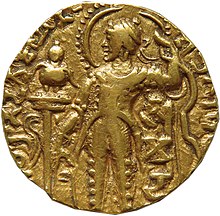
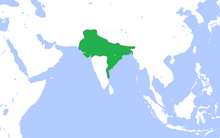


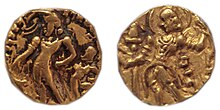




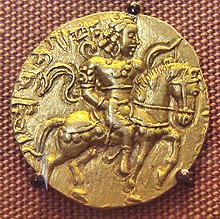
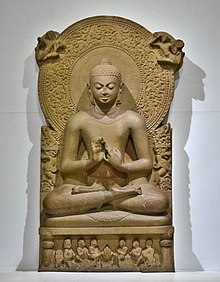
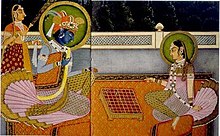



![The maximum extent of the Maurya Empire, as shown in many modern maps. See also this alternative map.[2]](https://upload.wikimedia.org/wikipedia/commons/thumb/2/2c/Maurya_Empire%2C_c.250_BCE_2.png/250px-Maurya_Empire%2C_c.250_BCE_2.png)
